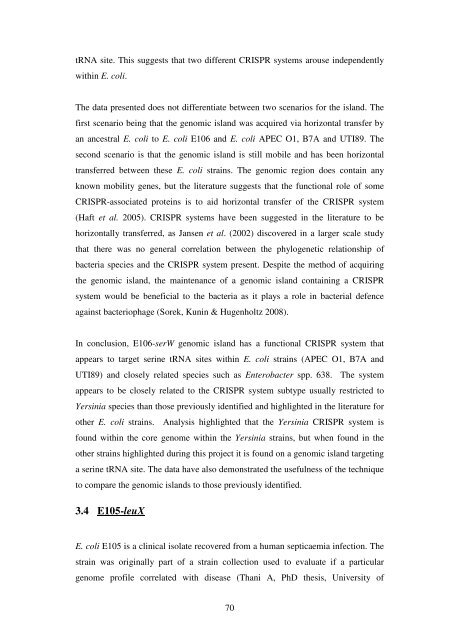5 The role of quorum-sensing in the virulence of Pseudomonas ...
5 The role of quorum-sensing in the virulence of Pseudomonas ...
5 The role of quorum-sensing in the virulence of Pseudomonas ...
Create successful ePaper yourself
Turn your PDF publications into a flip-book with our unique Google optimized e-Paper software.
tRNA site. This suggests that two different CRISPR systems arouse <strong>in</strong>dependently<br />
with<strong>in</strong> E. coli.<br />
<strong>The</strong> data presented does not differentiate between two scenarios for <strong>the</strong> island. <strong>The</strong><br />
first scenario be<strong>in</strong>g that <strong>the</strong> genomic island was acquired via horizontal transfer by<br />
an ancestral E. coli to E. coli E106 and E. coli APEC O1, B7A and UTI89. <strong>The</strong><br />
second scenario is that <strong>the</strong> genomic island is still mobile and has been horizontal<br />
transferred between <strong>the</strong>se E. coli stra<strong>in</strong>s. <strong>The</strong> genomic region does conta<strong>in</strong> any<br />
known mobility genes, but <strong>the</strong> literature suggests that <strong>the</strong> functional <strong>role</strong> <strong>of</strong> some<br />
CRISPR-associated prote<strong>in</strong>s is to aid horizontal transfer <strong>of</strong> <strong>the</strong> CRISPR system<br />
(Haft et al. 2005). CRISPR systems have been suggested <strong>in</strong> <strong>the</strong> literature to be<br />
horizontally transferred, as Jansen et al. (2002) discovered <strong>in</strong> a larger scale study<br />
that <strong>the</strong>re was no general correlation between <strong>the</strong> phylogenetic relationship <strong>of</strong><br />
bacteria species and <strong>the</strong> CRISPR system present. Despite <strong>the</strong> method <strong>of</strong> acquir<strong>in</strong>g<br />
<strong>the</strong> genomic island, <strong>the</strong> ma<strong>in</strong>tenance <strong>of</strong> a genomic island conta<strong>in</strong><strong>in</strong>g a CRISPR<br />
system would be beneficial to <strong>the</strong> bacteria as it plays a <strong>role</strong> <strong>in</strong> bacterial defence<br />
aga<strong>in</strong>st bacteriophage (Sorek, Kun<strong>in</strong> & Hugenholtz 2008).<br />
In conclusion, E106-serW genomic island has a functional CRISPR system that<br />
appears to target ser<strong>in</strong>e tRNA sites with<strong>in</strong> E. coli stra<strong>in</strong>s (APEC O1, B7A and<br />
UTI89) and closely related species such as Enterobacter spp. 638. <strong>The</strong> system<br />
appears to be closely related to <strong>the</strong> CRISPR system subtype usually restricted to<br />
Yers<strong>in</strong>ia species than those previously identified and highlighted <strong>in</strong> <strong>the</strong> literature for<br />
o<strong>the</strong>r E. coli stra<strong>in</strong>s. Analysis highlighted that <strong>the</strong> Yers<strong>in</strong>ia CRISPR system is<br />
found with<strong>in</strong> <strong>the</strong> core genome with<strong>in</strong> <strong>the</strong> Yers<strong>in</strong>ia stra<strong>in</strong>s, but when found <strong>in</strong> <strong>the</strong><br />
o<strong>the</strong>r stra<strong>in</strong>s highlighted dur<strong>in</strong>g this project it is found on a genomic island target<strong>in</strong>g<br />
a ser<strong>in</strong>e tRNA site. <strong>The</strong> data have also demonstrated <strong>the</strong> usefulness <strong>of</strong> <strong>the</strong> technique<br />
to compare <strong>the</strong> genomic islands to those previously identified.<br />
3.4 E105-leuX<br />
E. coli E105 is a cl<strong>in</strong>ical isolate recovered from a human septicaemia <strong>in</strong>fection. <strong>The</strong><br />
stra<strong>in</strong> was orig<strong>in</strong>ally part <strong>of</strong> a stra<strong>in</strong> collection used to evaluate if a particular<br />
genome pr<strong>of</strong>ile correlated with disease (Thani A, PhD <strong>the</strong>sis, University <strong>of</strong><br />
70














